
IMPORTANT POINTS
SCut wood only. Do not cut metal, plastics,
masonry,
SStop the saw if the chain strikes a foreign object. Inspect the saw and repair parts as necessary.
SKeep the chain out of dirt and sand. Even a small amount of dirt will quickly dull a chain
and increase the possibility of kickback.
SPractice cutting a few small logs using the following techniques to get the “feel” of us- ing your saw before you begin a major
sawing operation.
SSqueeze the throttle trigger and allow the engine to reach full speed before cutting.
SBegin cutting with the saw frame against
the log.
S Keep the engine at full speed the entire time you are cutting.
SAllow the chain to cut for you. Exert only
light downward pressure.
SRelease the throttle trigger as soon as the cut is completed, allowing the engine to idle. If you run the saw at full throttle with- out a cutting load, unnecessary wear can
occur.
STo avoid losing control when cut is com- plete, do not put pressure on saw at end of cut.
S Stop the engine before setting the saw down.
TREE FELLING TECHNIQUES
![]() WARNING: Do not cut near build- ings or electrical wires if you do not know the direction of tree fall, at night since you will not be able to see well, or during bad weather such as rain, snow, or strong winds. as fall is unpredictable.
WARNING: Do not cut near build- ings or electrical wires if you do not know the direction of tree fall, at night since you will not be able to see well, or during bad weather such as rain, snow, or strong winds. as fall is unpredictable.
Carefully plan your sawing operation in ad- vance. You need a clear area all around the tree so you can have secure footing. Check for broken or dead branches which can fall on you causing serious injury.
Natural conditions that can cause a tree to fall in a particular direction include:
SThe wind direction and speed.
S The lean of the tree. The lean of a tree might not be apparent due to uneven or sloping terrain. Use a plumb or level to de- termine the direction of tree lean.
SWeight and branches on one side. S Surrounding trees and obstacles.
Look for decay and rot. If the trunk is rotted, it can snap and fall toward the operator.
Make sure there is enough room for the tree to fall. Maintain a distance of
jects. Engine noise can drown out a warning call.
Remove dirt, stones, loose bark, nails, sta- ples, and wire from the tree where cuts are to be made.
Plan a clear retreat path
Direction of Fall
45_
FELLING LARGE TREES
(6 inches in diameter or larger)
The notch method is used to fell large trees. A notch is cut on the side of the tree in the de- sired direction of fall. After a felling cut is made on the opposite side of tree, the tree will tend to fall into the notch.
NOTCH CUT AND FELLING THE TREE
S Make notch cut by cutting the top of the notch first. Cut through 1/3 of the diameter of the tree. Next complete the notch by cut- ting the bottom of the notch. See illustra- tion. Once the notch is cut remove the notch of wood from the tree.
SAfter removing the cutout of wood, make the felling cut on the opposite side of the notch. This is done by making a cut about two inches higher than the center of the notch. This will leave enough uncut wood between the felling cut and the notch to form a hinge. This hinge will help prevent the tree from falling in the wrong direction.
Final cut here. 2 inches abov center of notch. ![]()
First cut
Notch
Second cut
Hinge holds tree on stump and helps control fall
Opening of felling cut
Closing of notch
10
